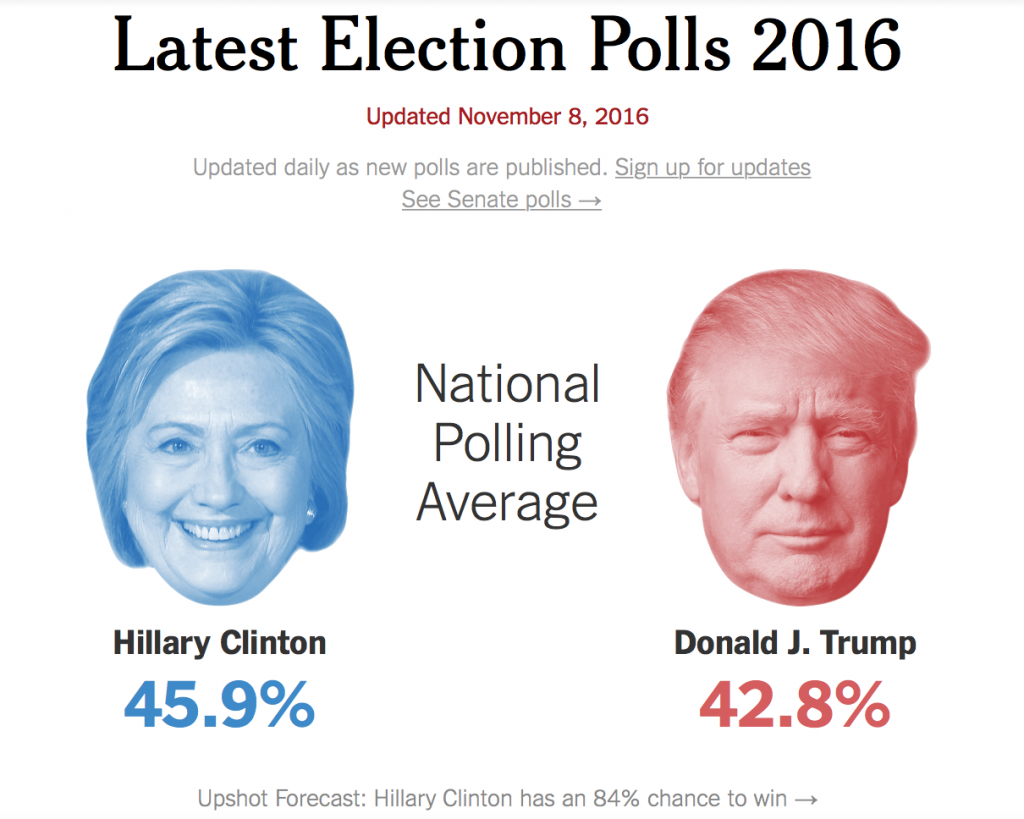What Happened during the 2016 Presidential Election?
Like mentioned in the book, the 2016 Presidential Election is a great example on why polling is not always perfect predicting an outcome of an election. However, a lot of the news organizations and scholars use polling information as a way to gain information and try to determine elections before they even occur. However, are pollsters and other research groups now have too much information to be effective (predicting the right outcomes)?

In this previous Presidential election, candidate Hillary Clinton had a lead of 1 – 7 percentage points in the popular vote based on polls. However, as we know now, the information the polls gathered predicted the outcome of the election wrong especially in terms of the electoral vote. According to the Pew Research Center, they identified three ways why the polls varied in results during the 2016 election. However, it is very tough to determine which of the three played the biggest factor in the results of the pre election polling.
The first way the Pew Research Center identified inaccurate polling is through a common sampling error called nonresponse bias. This occurs when individuals who are invited to express their opinion chose not to respond despite equal opportunity. The Pew Research Center suggests that pollsters had trouble getting responses from Trump supporters because his campaign targeted those who were less educated. Furthermore, according to NPR, they claim that due to his supporters being less educated, they are less likely to answer or stay on the phone when pollsters call.
The second explanation the Pew Research Center identified is that some people were “shy Trumpers.” This term describes individuals who lied to pollsters who were asking them their candidate preferences because it was deemed socially unacceptable to vote for Donald Trump. In states which are mainly Democratic, someone could definitely be a shy Trumper because of the fear of being rejected by the public for his or her views.
The last explanation the Pew Research Center identified has to do with the system that pollsters used to determine the sampling of individuals. Like most polls, the pollsters try to determine a sample which is representative of the group of people who are going to show up on election day. However, in the 2016 Presidential Election, the individuals who represented the Midwestern states did not show up to the polls on election day like most of the pollsters predicted. As a result, a large segment of voters which many thought were going to be the most important did not actually come to the polls.
Recently, polling has been turned into such a science with all the different types of forms of measuring public opinion. People can receive polls in the form of calls, texts, emails, websites, social media, face-to-face, mail, etc… As a result, does having too much information actually make poll results more inaccurate?
This video is CBS talking about why their polls and other pollsters were off on the 2016 Presidential Election:
Sources:
http://www.pewresearch.org/fact-tank/2016/11/09/why-2016-election-polls-missed-their-mark/
https://www.npr.org/2016/11/14/502014643/4-possible-reasons-the-polls-got-it-so-wrong-this-year
https://www.nytimes.com/interactive/2016/us/elections/polls.html